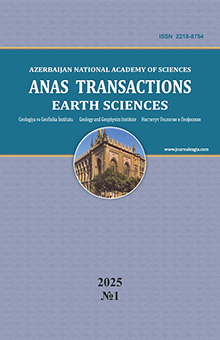Bouguer gravity data and satellite gravity transformation integration in the Caspian region: an introduction
1 Ministry of Science and Education of the Republic of Azerbaijan, Institute of Geology and Geophysics, Azerbaijan 119, H.Javid Ave. Baku, Az1143: kadirovf@gmail.com
2 Ministry of Science and Education of the Republic of Azerbaijan, Institute of Oil and Gas, Azerbaijan 9, F.Amirov ave., Baku, AZ 1000: kadirovf@gmail.com
3 Astronomical Institute, Academy of Sciences of the Czech Republic, Prague
4 Dept. of Geophysics, Tel Aviv University, Israel Ramat Aviv 6997801, Tel Aviv
5 Azerbaijan State Oil and Industry University 20 Azadlig Ave., Baku, AZ1010, Azerbaijan
6 Research Institute of Geodesy, Topography and Cartography, Zdiby, Czech Republic
7 Faculty of Mining and Geology, VSB-TU Ostrava, Czech Republic
Summary
Earth’s surface gravity measurements are essential (as close to the investigation targets) but insufficient. These measurements were carried out at different years, with various scales and accuracy and numerous white spots. The present epoch makes it possible to utilize various satellite gravity missions that have accomplished a great number of repetitions, the same grids, and the same accuracy. This paper considers satellite-derived data retracked to the Earth’s surface and transformed by various mathematical apparatuses. These data can be derived from the global Earth’s satellite data, mainly from the GRACE and GRACE-FO missions. The gravity gradient tensor Γ (the Marussi tensor) is a tensor of the second derivatives of the disturbing potential T of the gravity field model. This tensor was considered the centerpiece of traditional differential geodesy. It is analogous to the tidal deformation from geodesy and geophysics; one can imagine the direction of such a deformation due to “erosion” brought about solely by gravity. The strike angles usually show chaotic directions. We aim to detect where they are oriented dominantly in one prevailing direction (linearly or creating a halo around the object). Another applied gravitational parameter allows us to obtain the distribution of compressions and dilatations. The values may be used for detecting mainly subsurface structures: oil-gas fields, groundwater, and paleolakes. Integrating the conventional Bouguer gravity maps with satellite-derived gravity transformations will enable the generation of crucial physical-geodynamical and geological conclusions.
Keywords: Bouguer gravity map, satellite gravity measurements, gravity aspects, combed strike angles, dilatation, compression
REFERENCES
Alizadeh A.A., Guliyev I.S., Kadirov F.A., Eppelbaum, L.V. Geosciences in Azerbaijan. Volume II: Economic Minerals and Applied Geophysics. Springer. Heidelberg – N.Y., 2017, 340 p.
Eppelbaum L.V. Geophysical Potential Fields: Geological and Environmental Applications. Elsevier. Amsterdam – N.Y., 2019, 476 p.
Eppelbaum L., Katz Yu., Klokočník J., Kosteletský J., Zheludev V., Ben-Avraham Z. (2018). Tectonic insights into the Arabian-African Region inferred from a comprehensive examination of Satellite Gravity Big Data. Global and Planetary Change, Vol.171, 65-87.
Gravity map of the USSR. Scale 1:2500000, Ministry of Geology. Moscow, USSR, 1990.
Kadirov F.A. Gravity field and models of Azerbaijan’s deep structure. Nafta-Press. Baku, 2000 (in Russian).
Kadirov F., Floyd M., Alizadeh A., Guliyev I., Reilinger R., Kuleli S., King R., Toksoz, M.N. Kinematics of the eastern Caucasus near Baku, Azerbaijan. Natural Hazards, Vol. 63, No. 2, 2012, pp. 997-1006.
Kalvoda J., Klokočník J., Kostelecký J., Bezděk A. Mass distribution of Earth landforms determined by aspects of the geopotential as computed from the global gravity field model EGM 2008. Acta Univ. Carolinae, Geographica XLVIII, 2, Prague, 2013, pp. 17-97.
Klokočník J., Kostelecký J., Bezděk A. Gravitational Atlas of Antarctica. Springer. Dordrecht – N.Y., 2017, 124 p.
Klokočník J., Kostelecký J., Cílek V., Bezděk A. Subglacial and underground structures detected from recent gravito-topography data. Cambridge Univ. Press. Cambridge, 2020.
Klokočník J., Kostelecký J., Eppelbaum L., Bezděk A. Gravity disturbances, the Marussi tensor, invariants and other functions of the geopotential represented by EGM 2008. Journal of Earth Science Research, Vol. 2, No. 3, 2014, pp. 88-101.
Pedersen B.D., Rasmussen T.M. The gradient tensor of potential field anomalies: Some implications on data collection and data processing of maps. Geophysics, Vol. 55, No. 12, 1990, pp. 1558-1566.
DOI: 10.33677/ggianas20230100089
